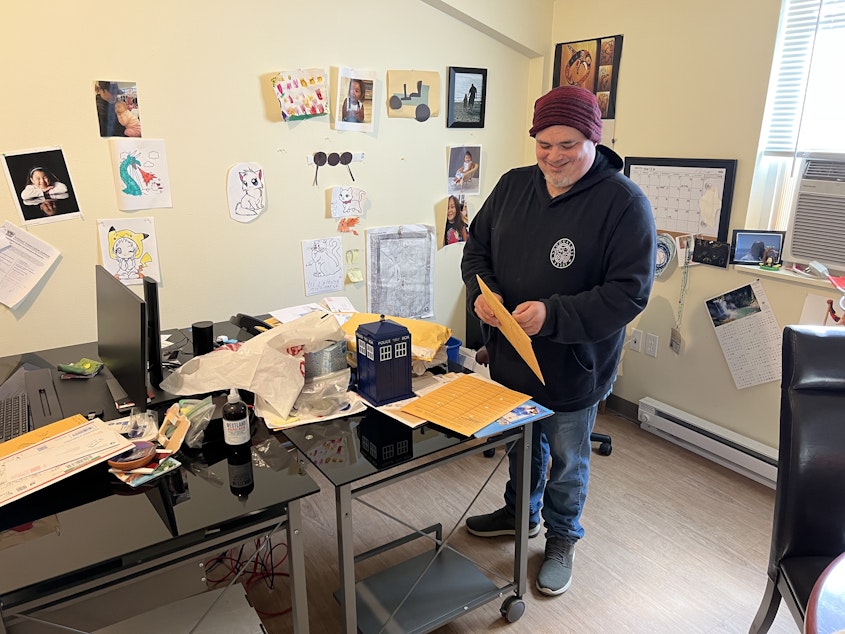Bringing ancestors home — the long process of recovering tribal remains

Museums around the nation have held items and ancestors from Northwest Indigenous communities for decades. Some tribes navigate a long and emotional journey to bring them home.
P
eople wearing formal clothing make their way into a community center building in northwest Washington state. It's a private event. Inside, harvested old-growth logs and polished floors shine. The space is filled with bleachers and natural light.
“It’s called Wex'liem," says Lena Tso, a historic preservation officer for the Lummi Nation. "It's named after the frog village, so it’s called the frog building.”
It's good for big celebrations. “There was a really big one on Saturday," Tso said.
Today though, a funeral is underway.
Sponsored
"When there’s a funeral, the family will gather and have all their funeral services here at the building,” Tso says.
A few miles down the road is the Lummi Nation cemetery.
Tso says the Nation has been officially working to protect its graves since the 1960s and '70s, decades before any federal law was in place to assist in the process.
As part of her job as a historic preservation officer, a role she's held for 17 years, Tso does a lot of work connected to the Native American Graves Protection and Repatriation Act, or NAGPRA. The law, passed in 1990, requires museums and other institutions that receive federal funding to make ancestral remains available for tribes to bring home.
“A lot of people kind of romanticize Indiana Jones, and, you know, his big deal was, ‘It belongs in a museum,'" Tso says in-between laughs. “Oh, my gosh Indy, no, no, it doesn't.”
Sponsored
When a university or museum needs to comply with NAGPRA guidelines, the conversation often begins with a letter to a tribe. Tso can spend years working to bring back an ancestor or cultural artifact. And each time she finishes one, the letters keep coming.
She says the process can be taxing.
“It almost feels like being re-traumatized over and over again,” she says. “Like every time something comes in. And it's like, Oh, my goodness. After a while, it becomes really heavy.”
There’s also an emotional weight for families. Tso says they go through a grieving process where there’s a chance at finding closure. She feels it, too.
Some projects have taken more than a decade. But despite the time and work it takes, she sees the value in NAGPRA, as do others who do this work.
Sponsored
While working with museums or universities, Tso has noticed what might make the repatriation process more efficient — beyond someone who manages collections, these institutions also need someone who understands NAGPRA and is focused on building relationships.
Mary Collins says she would have loved to have a partner in her work returning tribal remains and artifacts.
Collins was the director of the museum of anthropology for 19 years at Washington State University in Pullman. She’s retired now, but NAGPRA was passed right around the time she finished her post-grad degree in the early 1990s, and she was quickly swept up in the work of fulfilling its requirements. She says many of her peers then thought it was the end of archaeology and anthropology.
During that time, the original piece of legislation set the expectation for this work to be completed by 1995. Almost 30 years after that deadline, many universities and museums still hold remains that they have yet to return.
Collins says she had to start the work of returning remains, a task nobody had done before she arrived at WSU. She found success by putting in the time to build relationships.
Sponsored
“The advice I got was, ‘You got to get out there and talk to people,’” she said. “You can't sit here and write letters and expect anything to happen.”
After introductions are made, she says they would enter consultation, which was never a negotiation for her. She just listened and gave her tribal partners full access to the university’s records.
“I don't think I ever tried to interject an argument about trying to justify the past or excuse the past or anything like that," she says. "In some ways, I became much more aware of my neighbors and their history.”
Because of the work of Collins and others at WSU, 96% of the university's collection of tribal remains have been returned to their original communities. That’s 83 remains, according to a recent ProPublica report.
Steven Moses is doing this repatriation work as the director of archaeology and historic preservation for the Snoqualmie Tribe.
Sponsored
On his desk are two bags, filled with unopened mail. It's possible some letters are from museums and institutions reaching out about a tribal artifact or human remains in their possession.
“These letters are often addressed to the chair, or like, whoever was the historic preservation person 20 years ago, 30 years ago,” Moses says. “It can take a while to filter through.”
These letters are far from the most effective way for institutions to notify the tribes about a piece of their community that’s been taken away.
There’s a cemetery a short drive from Moses’ office. Elders are buried here. It’s also the resting place of people they get back from museums and collections.
“We've been bearing ancestors in [here] for thousands of years,” he says. “Most of it was taken over by the settlers and they came over, so there's a lot of that, the big names of Snoqualmie Valley history that are buried there too, but we have that small corner.”
In this cemetery, Moses and his staff at the preservation office dig parts of these graves by hand.
That’s partly because of tradition. But it’s also a way to protect the graves of the people they’ve buried here previously and to avoid disrupting that space.
New NAGPRA updates are expected to come before the end of this year.


